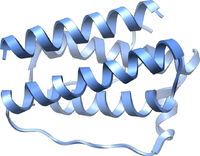
Photo from wikipedia
Eating palatable foods can provide stress relief, but the mechanisms by which this occurs are unclear. We previously characterized a limited sucrose intake (LSI) paradigm in which twice-daily access to… Click to show full abstract
Eating palatable foods can provide stress relief, but the mechanisms by which this occurs are unclear. We previously characterized a limited sucrose intake (LSI) paradigm in which twice-daily access to a small amount of 30% sucrose (vs. water as a control) reduces hypothalamic-pituitary-adrenocortical (HPA) axis responses to stress and alters neuronal activation in stress-regulatory brain regions in male rats. However, women may be more prone to 'comfort feeding' behaviors than men, and stress-related eating may vary across the menstrual cycle. This suggests that LSI effects may be sex- and estrous cycle-dependent. The present study therefore investigated the effects of LSI on HPA axis stress responsivity, as well as markers of neuronal activation/plasticity in stress- and reward-related neurocircuitry in female rats across the estrous cycle. We found that LSI reduced post-restraint stress plasma ACTH in female rats specifically during proestrus/estrus (P/E). LSI also increased basal (non-stress) FosB/deltaFosB- and pCREB-immunolabeling in the basolateral amygdala (BLA) and central amygdala specifically during P/E. Finally, Bayesian network modeling of the FosB/deltaFosB and pCREB expression data identified a neurocircuit that includes the BLA, nucleus accumbens, prefrontal cortex, and bed nucleus of the stria terminalis as likely being modified by LSI during P/E. When considered in the context of our prior results, the present findings suggest that palatable food reduces stress responses in female rats similar to males, but in an estrous cycle-dependent manner. Further, the BLA may contribute to the LSI effects in both sexes, whereas the involvement of other brain regions appears to be sex-dependent.
Journal Title: Neuroscience
Year Published: 2018
Link to full text (if available)
Share on Social Media: Sign Up to like & get
recommendations!